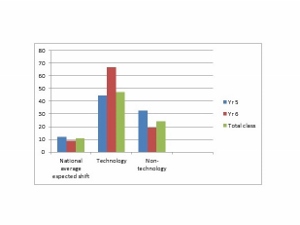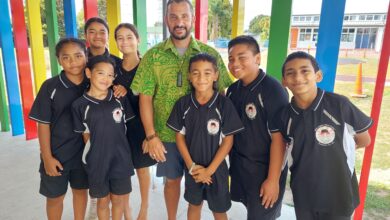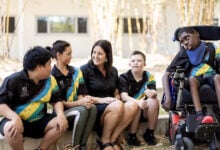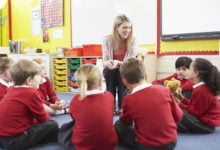Technological devices and children’s learning

 Parents and educators sometimes wonder what impact use of technological devices has on the learning and achievement of children.
Parents and educators sometimes wonder what impact use of technological devices has on the learning and achievement of children.
One Palmerston North school sought research data from the Institute of Education, Massey University, to inform decisions on whether to invest more heavily in technology. Dr Poskitt and Mr Jamieson discussed with the staff how to make the study manageable. We decided to focus on one curriculum area, reading comprehension, and conduct the research for one school term so that if technological use made a difference to student learning other classes could benefit.
Four classes (two year 4 and two composite year 5 classes) were involved, two of which used technological devices in their reading comprehension programme and two classes did not (i.e. one year four class used technological devices in their reading programme and the other year four class did not; similarly with the composite classes). Researchers gathered data at the beginning and end of the study (effectively pre- and post-testing) by observation, interview, student test (e-asTTle) and participating parent/caregiver questionnaire. The purpose was to monitor shifts so that if achievement increased the factors influencing it could be identified.
Four interesting results are discussed here: impact of technology use on reading achievement; student response to technology use; rate of reading achievement across the four classes; and pedagogical practices in reading comprehension.
Impact of technology use on reading achievement
Student e-asTTle test scores from the beginning and end of the school term were analysed to ascertain average point score shifts. For this analysis the difference between the beginning and end of term score was combined for each student in the ‘technology’ class and compared with the equivalent ‘non-technology’ class results. The results were very similar between the ‘technology’ and ‘non-technology’ year 4 classes and therefore the impact of technology use was inconclusive in year 4. Interestingly there was a significant difference in the composite year 5 classes, as seen in Figure 1.
For the older children in the research study, the use of technological devices made a significant positive difference to their achievement in reading comprehension (the green bars show students in the ‘technology’ class had higher average point score shifts than in the ‘non-technology’ class; whilst the red bars show the greatest difference between the year six students in the ‘technology’ class compared with the year six students in the ‘non-technology’ class).
Further analysis was done by gender (not illustrated here) to ascertain what difference the use of technology might make for boys. In the technology class the year 6 boys achieved an average point score shift of 56.7 (170/3) compared with the non-technology class boys average point score shift of 33 (232/7). These point score shifts related to small numbers of participants, but a tentative conclusion may be drawn that the use of technology in reading comprehension appears to make a greater difference to older, (year 6) students, and for boys.
Student response to use of technological devices
At the beginning of the study some students expressed hesitation in using technological devices, a few out of fear for detrimental effects on eyes and brain cells, other students through frustration with ‘technical aspects’ such as scrolling pages, losing information or previous searches; or through limited confidence. The year four ‘technology’ teacher discovered the students needed explicit instruction on how to: efficiently and critically search websites, scroll on iPads, move back and forth in their searching, transfer reading comprehension skills from print to electronic media (words and pictorial images), save learning on intranet sites and communicate via email. The older students needed less explicit instruction partly due to more experience and greater peer-to-peer informal learning that occurred. As students grew in familiarity and competence with various technological devices, their confidence increased as did their independence and enthusiasm for using technology. Students valued the ease and speed of researching information, creating high quality presentations, variety of ‘fun’ activities and contemporary learning.
Rate of reading comprehension achievement across the four classes
Participating teachers prioritised reading comprehension for the school term (e.g. school events like preparations for Dance NZ resulted in reading time being periodically rescheduled but rarely missed) and were curious to know the impact of technological devices on achievement. Each of the teachers was determined for his/her class to perform well.
Year 4 students (across the ‘technology’ and ‘non-technology’ classes) increased their reading comprehension average scores four times the national expected average whilst the composite year 5 classes increased three times. Moreover the older boys in the ‘technology class’ experienced positive shifts six times the national expected average – a fascinating trend when there is a prevailing educational concern about boys’ achievement. Levels of engagement increased noticeably during the research period, as well as confidence and competence in applying comprehension strategies in electronic medium. Children at the beginning of the study looked blankly at researchers when asked about comprehension strategies but by the end of the study they readily spoke about the application of terms like inference and prediction. However, for all of the classes the most important factor influencing achievement was the teacher.
Pedagogical practices in reading comprehension
In the ‘technology’ classes, “regular” technological devices were used, predominantly laptops and iPads, but also iPods, digital cameras, active boards/data projectors. Some of the ‘struggling’ readers used Lexia, while other children referred to particular programmes or websites such as Puppetpal, Kid Pix; Studyladder; PM+ readers; Keynote, Powerpoint, School Intranet, Pic-Collage, e-portfolios, Kiwi Kids news; Stuff news, Youtube clips and the like. Of interest to other schools may be the reality that no specialized electronic reading comprehension programmes were used and that devices were shared between classes to optimise device numbers during reading time. Participating teachers planned meticulously in reading with carefully targeted and varied ‘follow-up’ activities for children, active learning strategies (requiring children to think, create and apply their learning), and their instructional time with each reading group was highly focused. Teachers encouraged students to read brief passages for particular purposes (e.g. to find keywords, phrases that supported an inference, sentences that changed their predictions), followed by pertinent questions to elicit student responses which required them to use various comprehension strategies. Children were encouraged to summarise, to explain or justify their reasoning for inferences or predictions.
In discussions, teachers strove to optimise children’s participation by apt questioning; brief, specific task-related feedback (mostly directing student attention to details, alternative perspectives or requiring students to re-consider or think more deeply). A few brief observational extracts illustrate these pedagogical strategies:
Extract one (‘Non-technology’ yr 5 teacher)
T=teacher; G = girl; B= boy
Teacher working with reading group:
T: What is inferring or inference and how do you use it in reading?
G: Thinking on – reading between the lines
T: What does it mean, reading between the lines?
B: Working out what they are thinking when they wrote the story.
T: Good what do you use [to help you infer]?
B1: Words, title, pictures…
T: How do you know the person is angry by the word stomped?
B2: Because you have experienced it or seen others do it.
T: Right so you use prior knowledge to help you. Inferring can be quite hard. Sometimes the answers are in the text, or you draw on your prior knowledge to help you understand or read other books. Good readers ask questions during and after they read.
Other strategies teachers used were: to direct student attention to specific details (e.g. chapter title), break the task into smaller chunks (to optimise student attention and engagement), and give students a particular purpose to read (e.g. keywords to support their prediction).
Underpinning teacher practice was their openness to try new ideas, willingness to share and problem-solve (informally and more formally through professional learning sessions at team/staff meetings and interest groups like ‘iPad’ teachers). Professional sharing was evident in the consistent approaches to reading comprehension observed in the classrooms.
For this school the research revealed that: technological devices made a positive difference to the achievement for their senior students, and that effective pedagogical approaches enabled the four participating classes to make significant progress in reading comprehension.
Dr Jenny Poskitt, Senior Lecturer, Massey University









